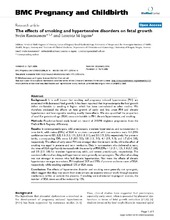| dc.description.abstract | Background: It is well known that smoking and pregnancy induced hypertension (PIH) are associated with decreased fetal growth. It has been reported that in preeclampsia the fetal growth deficit attributable to smoking is higher, which has been contradicted in other studies. We therefore evaluated the effects on fetal growth of early- and late onset PIH and chronic hypertension and how cigarette smoking modify these effects. We also quantified the proportion of small for gestational age (SGA) cases attributable to PIH, chronic hypertension, and smoking. Methods: Population-based study based on record of 215598 singleton pregnancies from the Medical Birth Registry of Norway. Results: In severe preeclampsia, mild preeclampsia, transient hypertension, and normotension in term birth, odds ratios (ORs) of SGA in smokers compared with non-smokers were 1.4 (95% confidence interval 0.9, 2.2), 1.6 (1.3, 1.9), 2.3 (1.8, 3.1), and 2.0 (1.9, 2.1), respectively. For preterm births, corresponding ORs were 1.3 (0.9, 2.0), 1.8 (1.1, 3.0), 4.1 (1.9, 9.0), and 1.7 (1.4, 2.0), respectively. The effect of early onset PIH was stronger than that in term births, while the effect of smoking was equal in preterm and term newborns. Only in non-smokers who delivered at term, the rates of SGA significantly increased with the severity of PIH (ORs = 1.3 (1.1, 1.5), 1.8 (1.7, 2.0), and 2.5 (2.2, 3.0) for transient hypertension, mild-, and severe preeclampsia, respectively). The combined effects of smoking and hypertension were generally not synergistic. The effect of smoking was not stronger in women who had chronic hypertension. Nor were the effects of chronic hypertension stronger in smokers. PIH explained 21.9 and 2.5% of preterm and term cases of SGA, respectively, while smoking explained 12% of SGA cases. Conclusion: The effects of hypertensive disorder and smoking were generally not synergistic, which suggest that they may exert their main actions on separate sites or work through separate mechanisms within or outside the placenta. If smoking were eliminated in pregnant women, the number of SGA cases would be reduced by 12%. | en_US |

